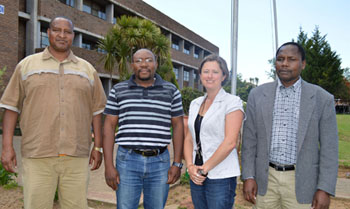
From the left are: Profs Birhanu Dejene, Oriel Thekisoe, Drs Aliza le Roux and Geofrey Mukwada. (Prof Riaan Luyt was absent due to being abroad.)
Photo: Thabo Kessah
|
The list of researchers at the UFS Qwaqwa Campus rated by the National Research Foundation (NRF) was strengthened with the addition of Dr Geofrey Mukwada, who will have recognition as established researcher (C) from 2015.
Mukwada is working in the Department of Geography. His research focus is rural livelihoods, sustainable rural livelihoods, conservation of natural resources and climate change.
A total of 119 UFS researchers currently have evaluation and rating status from the NRF, says Nico Benson, Deputy Director: Research Development. Currently (October 2014) 29 researchers are still waiting for response from the NRF regarding applications submitted. A total of 16 ratings are already known. Ratings are valid for a period of six years and researchers are invited to apply for re-evaluation in the fifth year.
On the Qwaqwa Campus, Profs Riaan Luyt and Birhanu Dejene enjoy status as established (C) researchers – Prof Luyt in polymer nano-composites and polymer compounds and Prof Dejene in solar energy (photovoltaic).
Dr Aliza le Roux and Prof Oriel Thekiso are recognised as promising young (Y) researchers. Dr le Roux’s research focus is behavioural ecology, predator-prey interaction, spatial cognition, cognitive ecology, communication, zoology, individual-based modelling, animal behaviour (primates, carnivore biology) and socio-biology (mammals).
Prof Thekisoe is conducting research on applied molecular diagnostics, ectoparasites, blood parasites, helminthology, molecular parasitology, entomology and parasitology, veterinary parasitology, parasitological techniques, host-parasite interaction and zoonosis.
These researchers are proud export products of the University of the Free State.